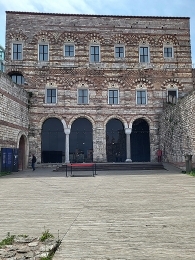ONCE A PALACE IN CONSTANTINOPLE, NOW A MUSEUM IN ISTANBUL
MUCH HAS CHANGED IN Istanbul since we last visited it in October 2008. Many places we saw then have either been restored or are closed for restoration. One place that was not open to visitors in 2008 is the Tekfur Sarayi, a palace built next to the ancient city walls of Istanbul. We came across it in April 2024 after having made an abortive visit to the nearby Kariye Mosque (once a Byzantine church), which was closed for restoration.
The Tekfur Sarayi, which used to be known as ‘Palace of the Porphyrogenitus’, is one of three Byzantine palaces still surviving in Istanbul. This edifice was constructed either in the late 13th century or early in the 14th. According to Wikipedia, the palace was:
“… named after Constantine Palaiologos, a son of the Emperor Michael VIII Palaiologos. “Porphyrogenitus”, meaning literally “born to the purple”, indicated a child born to a reigning emperor. The emperor would show off the newborn heir from the balcony and have them proclaimed “Caesar Orbi”, or “ruler of the world””.

The palace was badly damaged during the Ottoman conquest of Constantinople in 1453, and was later used to house part of the Sultans’ menagerie. By the end of the 17th century, the animals were moved, and the building housed a brothel. In 1719, the building was repurposed to house a factory for making decorative tiles, and this is how it remained before going out of business during the first half of the 19th century. Next, it became a poorhouse for some of the Jewish people in Istanbul. Following this, it became a bottle factory for a few years before being abandoned. What makes the building of special interest is that it is a rare surviving example of secular Byzantine architecture.
In 2010, the building was extensively restored and 5 years later a new roof and glazed windows were added. After that, new wooden floors and ceilings and staircases were added. In addition, a stylish lift was installed close to the palace. This allows visitors to reach the high second floor with ease. From a terrace on the second floor, there is a superb panoramic view of the city. In 2021, the place became a museum, whose exhibits include displays of the kind of tiling that used to be made in the palace and informative explorations of the stages in the traditional methods of manufacturing tiling. On the ground floor, there are a couple of archaeological remains of the kilns in which the tiles were fired. Apart from the exhibits, the elegantly contemporary design of the museum and what can be seen of the palace itself add much to the enjoyment of a visit to the Tekfur Sarayi.
The ground floor opens out into a courtyard where more archaeological finds can be viewed. A short staircase from the yard leads to a small garden from which one gets a good view of both the palace and the city walls stretching away from it. Although we were hoping to see the Kariye Mosque, but were unable to do so, visiting the Tekfur Sarayi more than adequately compensated us.



